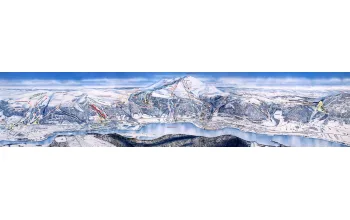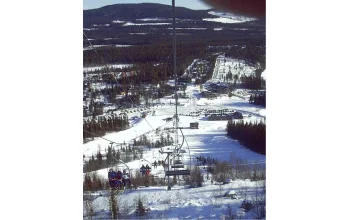The world's most northerly ski resort has offered skiing from February to June for all abilities since 1903, when the railway reached here. Great off-piste and heli-skiing. 250km within the Arctic Circle lifts operate under the midnight sun from mid-May.
Mountain
There are few ski resorts that attract such a mix of participants from the full range of snow disciplines. Cross country skiers, tourers, boarders, telemarkers and Alpine skiers all share the slopes amiably. You will see people in the latest gear and some happy to bring out skis and boots that have seen more than 20 winters. The lift served ski area is a short walk above the main resort complex. Double chair ascends from within a wooden shed, so in common with the triple chair above, you board indoors - good news in poor weather. The double chair rises above terrain marked red and black but unlikely to cause significant problems for anyone if intermediate standard. To the left of the lift there's a wide slope with lots of off piste opportunities, again that most intermediates would be able to tackle and enjoy if conditions are right. The upper slopes served by the triple chair are a little gentler. Again it is wide open terrain without trees or many dangerofours drops so is possible to ski off piste between the runs in comparative safety, as many people do. Run number 4 from the 909m summit is the one that takes you over the Norwegian border for a hundred metres or so. If you wish to stay in Norway keep left on route 3 continuing all the way back to the bottom of the double. There are off piste routes further in to Norway, catching the train back. If you want to go the whole hog there's an interesting ski area with great views of the North Sea at Narvik, in Norway, an easy excursion by train. A little closer on the line back in to Sweden are several other historic Swedish ski areas worth a day trip, if not so well known internationally. Closest is Abisko. Heliskiing is one of the major draws with short hops to one of dozens of peaks in the area highly affordable at around £110 ($200 US) for three ascents. Others prefer to hike up. There are 60 peaks in the area with an altitude over 1300m. Riksgransen's ski school is highly regarded in the skiing world. Although not many international guests think of coming to Riksgransen as novices, the ski school does offer classes for beginners, popular with the Swedes as well as a wealth of other possibilities up to steep and deep off piste guiding and tuition. Equipment rental is not a strength unfortunately. Although staff are good and the little rental shop well stocked, space and staffing is inadequate meaning long waits and unsatisfactory checking that the gear you're renting is likely to be suitable are the norm, unless you're lucky enough to arrive when no one is about. Another problem is that the Scandinavian norm is to charge for skis, boots and sticks as a package even if you just need skis and that the longest period you're likely to rent is charged for, so if you think you might only ski two out of four days, rather than paying for two and having the option to add on, you pay for four and get a small rebate if you return your gear a day or two early (and if you ask for the rebate!). Best to bring your own kit if possible.
Families
Families may feel a little daunted by the high proportion of young adult males that are dominant in Riksgransen and for smaller children in particular there is very little to do here beyond playing in the snow and checking out the extensive sweets collection in the supermarket. The groups of exuberant young adults can also be noisy at night time. There is no nursery provision and the swimming pool is very expensive with limited opening hours which do not include the daytime when everyone else is out on the slopes. Once on the slopes Riksgransen is a much more appealing prospect, the lift staff are very good at slowing the chairlift for small children to get on and get off and the uncrowded slopes are a fun park for children with innumerable bumps and jumps to enjoy. However the wide open nature of the terrain means the common problems of kids disappearing off piste in to trees or on to dangerous slopes and steep terrain is rarely an issue here.
Eating Out
The main place to eat is the large Lapplandia restaurant beneath the complex which normally offers both an affordable hearty fixed menu dish and a gourmet a la carte menu bringing in fresh cuisine from Lapland. Reindeer is often on the menu. There's a superb wine list for those happy to pay four times the cost outside Scandinavia! The recently upgraded Lappi's restaurant, at the base of the slopes and about 50 metres above the main complex offers a good selection of lighter fayre, mostly deli style, but with an open pizza oven. It's especially popular for lunches. During the day there's an internet café next to the shop off the reception area. It serves coffee, sandwiches and the like. The spa also has a small coffee shop area.
Apres
Apres is a mix of room-based parties and larger gatherings in the extensive bar beneath the complex which extends in to a night club - often with live bands performing. This has a grungy feel and a good selection of drinks as well as excellent service - however prices are exhorbitant, in common with all Scandinavian bars, thanks to high alcohol taxes, so most guests tend to nurse a £5 ($9 US) beer through the evening. The atmosphere is usually buzzing however. Tinned light beer bought in the supermarket is about a quarter of the price which is one reason why room-based-parties are popular.
Boarding
Riksgransen has become a hardcore boarders mecca just as it has long been for skiers. Pro boarders arrive each winter in force to make the most of the superb natural terrain (there's no machine made features, but none needed), heli-boarding and touring - as well as a totally boarders friendly environment. Most of the sport's stars have been here at one time or another. Ingemar Backman made his record breaking 'Ingemar's Air' jump here in the mid '90s.














